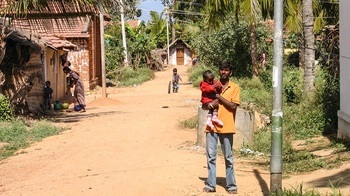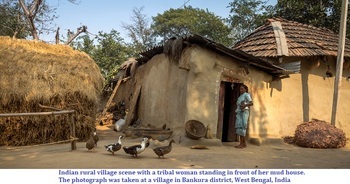

The concept of the village has played a  significant role in the historical study of India. The village has frequently been considered the pinnacle of ‘genuine native life,’ a location where people might witness the "true" India and witness how locals structure their social networks and worldviews. The study of the Indian village is one of the important academic traditions for social anthropologists.
significant role in the historical study of India. The village has frequently been considered the pinnacle of ‘genuine native life,’ a location where people might witness the "true" India and witness how locals structure their social networks and worldviews. The study of the Indian village is one of the important academic traditions for social anthropologists.
The "village" has remained to be seen as the  fundamental building block of Indian society even in the post-Independence era. The majority of social anthropological studies were released in the 1950s and 1960s. These "village studies" were crucial in establishing sociology and social anthropology as legitimate academic fields in India. Social anthropologists focused on the institutional structures and values of the village people as well as the forms of social connections and institutional relationships through society based on fieldwork, or what became known as the "field-view" of India.
fundamental building block of Indian society even in the post-Independence era. The majority of social anthropological studies were released in the 1950s and 1960s. These "village studies" were crucial in establishing sociology and social anthropology as legitimate academic fields in India. Social anthropologists focused on the institutional structures and values of the village people as well as the forms of social connections and institutional relationships through society based on fieldwork, or what became known as the "field-view" of India.
Anthropological investigations challenged the myth that Indian villages were self-sufficient societies. The village had a ‘complex system’ of social interactions and included institutional arrangements where internal diversity prevailed by numerous groupings.
Their interaction with the outside world did not mean that the villages did not have their own unique design. Although there were horizontal links in villages, a large portion of an average villager's life was dictated by the vertical ties within the community. In this sense some important characteristics of Indian village are −
For its citizens, the village served as a crucial source of identity.
According to Srinivas, people in villages felt an awareness of identity through their community, and a harm to one's community felt like an insult to their wife, family, or oneself.
As a unit of social organisation, the village settlement stood for a type of solidarity distinct from that of kin solidarity, caste solidarity and class solidarity.
Every village was a unique entity with its own customs and practises as well as a sense of communal cohesion.
The village's diverse castes and communities were included into its economy, society, and religious structure by connections of ‘reciprocal’ duties that were approved of and upheld by universally accepted customs.
In Indian villages, individuals were classified into higher or lower social classes based on hierarchy. The first three Varna were known as Dvijas, and included Brahmins, Kshatriyas, and Vaishyas. The fourth category, known as Shudras, included a variety of occupational castes that were considered to be reasonably "clean" and not considered to be "untouchables." All of the "untouchable" castes were grouped together in the fifth category.
Another feature of the Indian villages is the overlapping of the caste and land. The higher caste Brahmins and Lingayats made up the majority of the wealthier landowners, while the Harijans made a sizable portion of the labour power.
The markets are an essential feature of the Indian village. The Haats, or weekly markets, provide vital connections to nearby villages and towns. They serve as crucial hubs for bringing in products that are not readily available locally.
Caste-based specialisation means that only some people can perform specific activities; for example, only members of the potter caste can produce pots. Even in the case of the smaller communities, not all of the artisan and serviceable castes resided in a single village. Likewise, for its basic requirements in food grain, raw materials for processed food, and handicrafts, the urban sector is dependent on the rural hinterlands.
Every investigation into Indian village tradition reveals some kind of relation between the village's culture and the larger Indian culture. In this sense Robert Redfield (1955) coined the terms "great tradition" and "little tradition," which McKim Marriott has adapted as "universalization" and "parochialization" to describe the two aspects of this doubly complex phenomenon.
Through Sanskritization and universalization village traditions can be associated with the larger Indian tradition. For example, the association of a local God or Goddess with a Hindu pantheon deity is an identification of local deity with the greater religion. The local cobra deity is thus associated with Subramanya or Skanda, the warrior son of Shiva, while Ketrappa is identified with the Vedic deity Kshetrapala among the Coorgs. This facilitated the integration of the Coorg religious community into the larger Hindu religious community.
The notion that the village in pre-British India was politically independent other than paying taxes to the local chief or the monarch and producing young men for wars is untrue. The villages had a close relationship with the state in pre-British India. The village panchayat was established by the dominant caste to administer local affairs, resolve caste conflicts, and uphold law and order in the community. With the establishment of British colonial control, the relationship between the village and the ruler shifted.
In the current system, villagers choose representatives for the state legislature and the Parliament in addition to local authorities like the Gram Panchayat. Regional and national political parties become active in the village during election campaigns and mobilise support for their parties.
Hence, we can say that when capitalism reached rural areas, the village market was connected to the established market networks. Different villages have varying access to new economic prospects, particularly as a result of industrialization and urbanisation processes that integrated the village into the larger economic system.
Q1. What do you understand about “universalization” and “parochialization”?
Ans. “Universalization” refers to the incorporation of village cultural elements into a large region or society and "parochialization" refers to the diffusion of certain elements of various Indian cultures down to the village areas through different ways of communication like ‘story-telling’ and ‘folk drama’.
Q2. Can people from lower caste become a part of a higher caste?
Ans. Yes, according to M.N. Srinivas, through Sanskritization people from lower castes could attain or become a part of higher caste. This ‘upward mobility’ of lower caste is not easy and a lot of sacrifices, rituals and traditions are required to be performed.
Q3. What was the Britisher’s notion of Indian villages?
Ans. Early nineteenth-century British administrators referred to Indian villages as "little republics" because of their straightforward system of self-government and the minimal intervention from higher governmental authorities.